|
|
|
Commercial Road, towards Limehouse |
|
This
part of Commercial Road has the
magnificent St Ann s Church whose tower dominates the whole of
Limehouse. In front of
the tower is Limehouse Town Hall, opened in 1870.
While on the other side of the road is the Britannia public
house, standing beside the Limehouse Cut, constructed in 1770, and the
Britannia Bridge. This
broad and very busy road stretches for a mile and three-quarters from
Aldgate to Limehouse. It was
constructed in 1803 to link the West India Docks and East India Docks with
the City of London. Soon, it
was to become the main thoroughfare for dock traffic from the Royals
and Tilbury as well. Construction
for the Road was given by an Act of Parliament to the Commercial Road
Company, whose trustees were allowed to raise money and levy tolls.
With ruthlessness and Roman planning the road cut a near straight
line through the East End, taking in its way a large portion of St Ann s
Churchyard. With ever
increasing dock trade, the
Company decided in the 1830s to construct a stone tramway of Aberdeen
granite along its entire length, enabling goods to be move along the road
more easily. In the 1860s, Commercial Road became a public road when control passed to a number
of local Metropolitan Boards of Works and tolls were then abolished. Salmons
Lane joins Commercial Road from
the left at the bridge. It
was here, at a small open space, that Oswald Mosely was to have addressed
his assembled marchers during their march through the East End, from Royal
Mint Street to Victoria Park, on the 4th October 1936.
They never arrived. Stopped
by crowds of demonstrators at Cable Street and Gardener s Corner, the
march never even started. Limehouse
Town Hall, a Grade II listed building, was built with an impressive
entrance, a magnificent staircase and impressive Concert Hall, on the
first floor. In the 1920s it
housed the Local Rates Office and Infant Welfare Centre.
During the Second World War, the Town Hall received severe blast
damage and remained closed for a number of years.
Restored, the Town Hall again became Council Offices again until
the 1970s when it became the National Museum of Labour History - mostly
London Labour Dock History. In
the 1980s, the Museum moved, because of funding problems, to Manchester! After
being empty for a number of years the Limehouse Town Hall Consortium Trust become the custodians of the building in 2004. |

